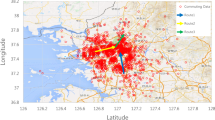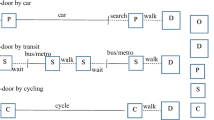Abstract
Local governments in Republic of Korea provide local mobility services (e.g., taxis and buses) for transportation vulnerable areas with limited access to mass public transit. However, the losses incurred by the operation of these local mobility services have led to the fiscal burden for subsidizing the local mobility services. To address this problem, autonomous mobility service is emerging as an alternative mode of transportation that can reduce the operating costs for the local mobility services (e.g., labor and fuel costs). This study proposes a step-by-step strategy for introducing autonomous mobility services in Gyeonggi Province, where there are a number of transportation vulnerable areas mainly due to geographical disparities. First, this study applied the Gaussian mixture model (GMM) to classify the transportation vulnerable areas, and the areas were clustered into four classes. Then, the strategy for introducing the autonomous mobility service target to each of the transportation vulnerable areas classified. Finally, the strategy was evaluated by checking them against the actual status of mobility service. The result derived from our proposed methodology contain 4 clusters with the order of introducing autonomous mobility services and is verified with the current status of welfare public transportation.
Similar content being viewed by others
References
Adey P (2017) Mobility, 2nd edition, Routledge: Abingdon-on-Thames, UK
Aguilera A, Boutueil V (2018) Urban mobility and the smartphone: Transportation. Travel Behavior and Public Policy, 1st edition, Elsevier: Amsterdam, Netherlands
Bennett R, Vijaygopal R, Rita K (2020) Willingness of people who are blind to accept autonomous vehicles: An empirical investigation. Transportation Research Part F: Traffic Psychology and Behavior 69:13–27, DOI: https://doi.org/10.1016/j.trf.2019.12.012
Bentenrieder M (2010) Mein haus mein pool meine mobilität. Automotive Agenda 3(4):34–43, DOI: https://doi.org/10.1007/BF03223794
Bernhard C, Oberfeld D, Hoffmann C, Weismüller D, Hecht H (2020) User acceptance of automated public transport: Valence of an autonomous minibus experience. Transportation Research Part F: Traffic Psychology and Behavior 70:109–123, DOI: https://doi.org/10.1016/j.trf2020.02.008
Beutel MC, Gökay S, Kluth W, Krempels KH, Samsel C, Terwelp C (2014) Product oriented integration of heterogeneous mobility services. Proceedings of 17th International IEEE Conference on Intelligent Trasportation System. Qingdao, China, 8–11 October, DOI: https://doi.org/10.1109/ITSC.2014.6957650
Bin G, Joh C, Son S (2020a) A study of inferring factors of the commuter’s mode choice considering the introduction of the autonomous driving shuttle services. Gyeonggi Research Institute 1–160
Bin M, Joh C, Son S (2020b) A study on the influencing factors of the use of autonomous vehicle transit services: Focusing on the commuters of pangyo 2nd techno valley. Korean Society of Transportation 38:415–430
Bin M, Kim Y (2017) Emergence of autonomous vehicle and change to environment of traffic use. Gyeonggi Research Institute 1–21
Bong I, Choi H (2019) Evaluation and suggestion of the adequate housing in Gyeonggi-Do. Gyeonggi Research Institute 1–78
Choo S, Sohn D, Park M (2016) Mobility characteristics of the elderly: A case for seoul metropolitan area. KSCE Journal of Civil Engineering 20(3):1023–1031, DOI: https://doi.org/10.1007/s12205-016-0651-x
Cresswell T (2006) On the move: Mobility in the Modern Western World, 1st edition, Routledge: Abingdon-on-Thames
Csiszár C, Földes D (2018) Operational model and impacts of mobility service based on autonomous vehicle. Proceedings of the Fourth International Conference on Traffic and Transport Engineering. Belgrade, Serbia, 27–28 September
ElMoaqet H, Kim J, Tilbury D, Ramachandran SK, Ryalat M, Chu C-H (2020) Gaussian mixture models for detecting sleep apnea events using single oronasal airflow record. Applied Sciences 10:7889, DOI: https://doi.org/10.3390/app10217889
Földes D, Csiszár C (2018) Framework for planning the mobility service based on autonomous vehicles. Proceeding of 2018 Smart City Symposium Prague. Prague, Czech Republic, 24–25 May, DOI: https://doi.org/10.1109/SCSP.2018.8402651
Fuchs M, Gaussian Mixture Model (2020) Available online: https://michael-fuchs-python.netlify.app/2020/06/24/gaussian-mixture-models/ (accessed on 1 November 2021)
Govender P, Sivakumar V (2019) Application of k-means and hierarchical clustering techniques for analysis of air pollution: A review (1980–2019). Atmospheric Pollution Research 11(1):40–56, DOI: https://doi.org/10.1016/j.apr.2019.09.009
Han J, Ahn H, Yang S (2015) Operation strategies & promotion plan for demand responsive transport systems in vulnerable area to transport. Incheon Development Institute
Jang S, Baek SI, Choi BS (2018) Issues and policy issues for the commercialization of autonomous vehicle. Trends and Issues 49:1–31
Kim C, Han A (2018) Gyeonggi-do main bus policy evaluation and development method: Focusing on metro buses and customized buses. Gyeonggi Research Institute 1–107
Kim KO (2019) Issues and directions for improving the publicity of autonomous driving public transportation. Broadcasting and Media Magazine 24:73–83
Kim S, Park H, Lee H (2020) The diffusion barriers of AI mobility service: The case of TADA. Proceeding of 2020 International Conference on Artificial Intelligence in Information and Communication. Fukuoka, Japan, 19–21 February, DOI: https://doi.org/10.1109/ICAIIC48513.2020.9065038
Ko YS, Kim HJ, Kim HS (2011) The establishment of the national minimum standard on transport services focused on the accessibility of the road infrastructure. Korea Research Institute for Human Settlements
KPMG (2020) Autonomous Vehicles Readiness Index (AVRI). Available online: https://home.kpmg/xx/en/home/insights/2020/06/autonomous-vehicles-readiness-index.html (accessed on 13 September 2021)
Lessa DA, Lobo C, Cardoso L (2019) Accessibility and urban mobility by bus in Belo Horizonte/Minas Gerais-Brazil. Journal of Transport Geography 77:1–10, DOI: https://doi.org/10.1016/j.jtrangeo.2019.04.004
Lim S, Jang W, Tak S, Park T (2018) Strategies of public transport service in the era of autonomous vehicle and shared transport. The Korea Transport Institute
Merriman P (2009) Mobility. International Encyclopedia of Human Geography 134–143, DOI: https://doi.org/10.1016/B978-008044910-4.00300-X
Mishra S, Cherry CR, Golias MM, Sultana Z, Jordan S, Tabrizizadeh S (2018) Assessment of Mobility and Transit Access to Captive Riders in Suburban and Rural Areas
Mo C, Park J, Park S (2013) Study on the methodology of measurement and setting up the standards of minimum services for transport rights: Focusing on bus and DRT in rural areas. The Korea Transport Institute 1–255
Pan H, Liu W, Yan K, Xu M, Ye Song, Wei Peng (2013) Sustainable urban mobility in Eastern Asia. Regional study prepared for Global Report on Human Settlements 2013
Park J, Kim K (2020) Measures to strengthen transportation service in rural areas. National Assembly Research Service
Park K (2010) A study on the transportation competitiveness of the cities in Gyeonggi-Do. Gyeonggi Research Institute 1–131
Park K, Song K, Jung H (2019) A study on the route selection method for demand response transport (DRT) replacement for bus services in vulnerable areas - Focused on region vulnerable to public transportation of GyeongSangNam-Do in Korea -. Journal of Korea Planning Association 54(4):71–78, DOI: https://doi.org/10.17208/jkpa.2019.08.54.4.71
Roh C-G, Jeon H (2021) Decision-making process for demand response public transportation service design — A case study in Incheon, Korea. Sustainability 13:5574, DOI: https://doi.org/10.3390/su13105574
Ryu S, Yu J (2020) A study on road policies of Gyeonggi-do in Response to the Era of Connected and Autonomous Vehicles. Gyeonggi Research Institute 1–69
Smith N, Hirsch D, Davis A (2012) Accessibility and capability: The minimum transport needs and costs of rural households. Journal of Transport Geography 21:93–101, DOI: https://doi.org/10.1016/j.jtrangeo.2012.01.004
So J, An H, Lee C (2020) Defining smart mobility service levels via text mining. Sustainability 12:9293, DOI: https://doi.org/10.3390/su12219293
Solomon J, Titheridge H (2009) Setting accessibility standards for social inclusion: Some obstacles. Proceedings of the 41st Universities Transport Studies Group Annual Conference. London, UK, 5–7 January
Song H, Jang D, Kim H (2006) Income polarization and conditions of working poor in gyeonggi province: Social policy approach. Gyeonggi Research Institute 3–20
Song J, Kim H (2018) A study on the improvement of demand-responsive taxi service in Gyeonggi-Do. Gyeonggi Research Institute 1–102
Tak S, Kim H, Kang K, Lee D (2019) A study on the introduction for automated vehicle-based mobility service considering the level of service of road infrastructure. The Journal of The Korea Institute of Intelligent Transport Systems 18(5):19–33, DOI: https://doi.org/10.12815/kits.2019.18.5.19
Vigar G (2001) The politics of mobility: Transport planning, the environment and public policy. 1st ed.; Spon Press: London, UK
Wang Z, Cunha CD, Ritou M, Furet B (2019) Comparison of K-means and GMM methods for contextual clustering in HSM. Procedia Manufacturing 28:154–159, DOI: https://doi.org/10.1016/j.promfg.2018.12.025
Whelan G (2007) Modelling car ownership in Great Britain. Transportation Research Part A: Policy and Practice 41(3):205–219, DOI: https://doi.org/10.1016/j.tra.2006.09.013
Yoon T (2020) Policy plan for efficient introduction of autonomous public transportation services. Korea Research Institute for Human Settlements 748
Acknowledgments
This work was supported by the National Research Foundation of Korea (NRF) grant funded by the Korea government (MSIT) (No. 2020R1C1C1003296).
Author information
Authors and Affiliations
Corresponding author
Rights and permissions
About this article
Cite this article
Seo, Y., Lim, D., Kim, J. et al. Strategy for Introducing Autonomous Driving Mobility Service in Transportation Vulnerable Areas: A Case Study of Gyeonggi Province in Republic of Korea. KSCE J Civ Eng 26, 4793–4804 (2022). https://doi.org/10.1007/s12205-022-0248-5
Received:
Accepted:
Published:
Issue Date:
DOI: https://doi.org/10.1007/s12205-022-0248-5




